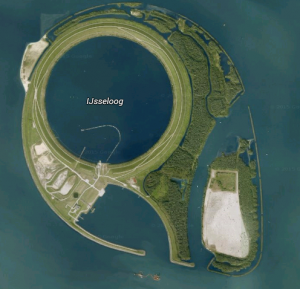The IJsseloog – Made by Dutch Hands? Posted by Sten on Jun 18, 2015 in Uncategorized
A strange, round shape can be found right in the IJsselmeer. A deserted and lonely island? Did nature create that? Aliens?
It is a bit weird. There are roads all around that hole, and even some buildings it seems.
What is that weird round eye right in the Ketelmeer between the two parts of the Dutch province Flevoland?
For other posts in the series Strange Places in the Netherlands, click here.
It is much less scary than it seems. This island is called the IJsseloog (IJssel Eye), as the round shape reminds of an eye, and it is located at the estuary of the IJsselmeer, the huge lake in the middle of the Netherlands, closed off by the Afsluitdijk from the North Sea.
As you may guess now, this Island did not come into being naturally. It is pushed up ground, made artificially, something the Dutch are masters at. Much of the ground of the Netherlands nowadays had been underwater before. The entire province of Flevoland is actually created by this method. More on that in another post to come!
So why this IJsseloog?
Well, first and foremost it serves quite an important purpose: catch all the water that is polluted with slib (sludge). Slib is a sediment in water, which was already used by the Egyptians to fertilize their lands. In the past decades, however, that slib has been polluted with heavy metals.
Rijkswaterstaat (Dutch Ministry of Infrastructure and Environment) was concerned about this pollution, as it wanted to prevent this pollution of spreading throughout the IJsselmeer, and kill fish, get into water used for agriculture and other uses (the IJsselmeer holds fresh water!).
Cleaning the slib is too cumbersome – and therefore a permanent deposit was needed.
This is the IJsseloog. You may wonder why it was not just created on land, but this decision was made to prevent contamination with water that farmers use, and to prevent water to drain there. And in the water the Dutch found a smart solution to keep the slib from mixing – and it is a typically Dutch solution!
Check out this picture, and zoom in. A hint: check the water levels. Do you see it? Yes: the level of the slib, inside the IJsseloog, is lower than the water around it of the Ketelmeer! To be exact: the slib in the IJsseloog is 4 m (=13 ft) below sea level, and the average water level of the Ketelmeer is just 2.4 m (8 ft). So by having 1.6 m (5 ft) lower waste water and a 10 m (30 ft) high dyke around it, the chance of contamination is pretty much zero. Awesome? Yes.

Build vocabulary, practice pronunciation, and more with Transparent Language Online. Available anytime, anywhere, on any device.
About the Author: Sten
Hi! I am Sten, both Dutch and German. For many years, I've written for the German and the Dutch blogs with a passion for everything related to language and culture. It's fascinating to reflect on my own culture, and in the process allow our readers to learn more about it! Besides blogging, I am a German-Dutch-English translator, animator and filmmaker.




